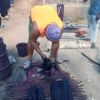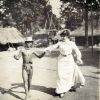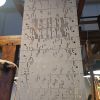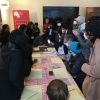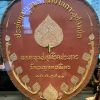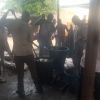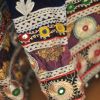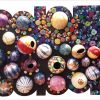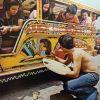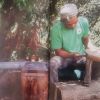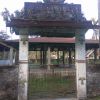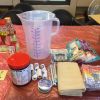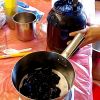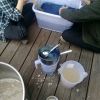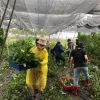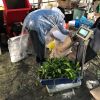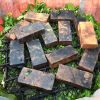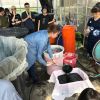The search found 57 results in 0.018 seconds.
Search results
In the winter of 2021 while visiting family in Pakistan, I was searching the carpet stores of Islamabad for an affordable rug to take back to Toronto. Islamabad, with the highest number of foreign diplomats in Pakistan, is full of art and craft stores in central locations which cater mainly to non-Pakistanis. As compared to stores which target locals, these craft stores have a well-curated collection of ‘authentic-looking’ craft that appeal more to Western palates.
The Indigo Dyeing Tradition in Daboya: Notes from the Field
Daboya is a semi-urban community in the Savanna Region of Ghana. It is well noted for its organic indigo textile dyeing and weaving tradition which dates back to over three centuries. Before the introduction of synthetic dyes, Indigo was the foundation of most textile traditions in West Africa. In Ghana, most of the traditional smock dresses and related fabrics that are worn are produced in Daboya. Below, I present an account of the indigo dyeing process as observed in Daboya in May 2022.
Attached here is an archival photograph from the Missouri Historical Society of the 1904 St. Louis World’s Fair, specifically of indigenous Filipinos from the Cordillera region of northern Luzon known as the Igorots. Titled by American photographer Jessie Tarbox Beals (1870-1942) as “Mrs. Wilkins teaching an Igorrote boy the cakewalk at the 1904 World’s Fair,” the photographs presents two people in the image, the eponymous young Igorot boy dancing with Vienna opera singer Mrs. George S. Wilkins, as she teaches him the cakewalk, a popular dance of the time period.
Clad in polka dots,
Eyes glitter despite wet toes,
Exchanging this love.
After days of rain, the sunlight
shimmers – dappled shadows dance.
Living tradition,
Colors bleed transformation,
An elsewhere awaits.
What do our bodies know that
text cannot articulate?
Shuttling asleep,
Lines collapse past and future.
Who holds the power?
Resisting capture, its wings
flutter, fighting off the pin.
The first photograph is one that depicts a Jacquard loom print card, a piece of cardboard that has been punctured with holes in order to consistently replicate a complex design on a weaving loom. This particular print card would have been used to create handmade Dutch damask linen in the 19th century, as part of the W.J. van Hoogerwou & Zonen mill whose pieces are currently located at the Textielmuseum in Tilburg, Netherlands. One such product of damask linen would be a tablecloth, which was also on display nearby.
As we walked through the hall of "Asia" to reach "Africa," the Volkenkunde Museum's only displayed object from Thailand caught my eye, its embroidered metal threads glinting in the dark. Embroidered script and teardop-shaped lotus buds adorn a piece of silk stretched tight around a frame to form an oblong fan that would have been held by a monk near his face as he chanted during rituals at a temple, in a homes, or in other spaces where monks are invited to preside.
Field Work to Bulamari Local Dyeing Centre, Maiduguri, Borno State.
Bulamari Dyers are the Kanuri speaking indigenes of Maiduguri, Borno State. They Specializes in the production of the Kanuri tie and dye attires, especially the Kanuri blue and black fabric known as “Dongashou”.
The findings of the survey carried out at Bulamari Dyeing Center, behind the Shehu Palace in Maiduguri, Borno State are as follows:
This beautiful embroidery from Afghanistan is commonly done on velvet, in this case a soft royal blue fabric, that highlights the embroidery very well.
Beauty is the quality present in a thing or person that gives intense pleasure or deep satisfaction to the mind, it can also be a combination of qualities, such as shape, colour, or form that pleases the aesthetic senses, especially the sight.
The first photograph was one taken by Italian actress and photojournalist Gina Lollobrigida in 1975 Cubao, a district within Quezon City, one of the most populated cities in the Philippines. The photograph captures 6 onlookers (including the driver) watch as an artist paints onto the driver’s jeepney a man blowing wind into the mountains while the sun rises. The other photograph, of jeepney artist Vic Capuno in 2018, shows him painting a monster truck onto the side of a jeepney in his San Pedro workshop.
This photograph, taken from the Philippine National Commission for Culture and the Arts (NCCA)’s book on living traditions in the Philippines, is of a trainee artisan as he pounds a brass plate into the shape of a gangsa, a round, smooth-surfaced handheld gong used by the Cordillera peoples in the Benguet region of Luzon.
Luntaya acheik means the silk thread woven in the method of acheik into the wavy rope pattern through the use of a hundred small shuttle looms. This acheik can be woven in silk only.
When the day came to be, Kohima was resplendent in sunshine. It was January 10, 2018, the first Naga Day. At the Kohima Local Ground, Khuochiezie, music played from the early morning hours.In the surrounding market area, people hummed the tunes as they set up shop. Some planned to go to the ground, some planned to watch from their terraces—everyone had heard this one thing, Nagas from everywhere were coming together.
Bakhri II
The community Bakhri (Granary) at Thuribari, Kokrajhar, is one of the few such Bakhris seen nowadays in Assam. Community Bakhri is representative of a communal living and sharing. Located in an open village space just opposite the Brahma temple, these three small raised mud houses look ordinary but the significance and relevance of them in Thuribari community life is clearly visible from the well-maintained condition of it.
Many of us may have seen or bought indigo products from market. Seldom do we have the privilege to explore the beauty and hardship of a craftsmanship, know the process and knowledge of it from school. For the semester of Spring 2019, there is a course "Blue Across Boarders", which provided students a brief understanding of indigo, from plants, process of making indigo dye to dyeing, also provided them a chance to witness the process and experimented with dyeing by themselves in school.
Traditional handicrafts are a kind of embodied local knowledge, so does indigo. On the course of "Blue Across Boarders", students had a chance to talk with artisan Tang Wen-chun (湯文君), who is also an educator, motivator and researcher on indigo. Tang introduced the plants of indigo which are harvested in her farm, the practice she was conducting on also the process and tips for harvesting plants of indigo. Students had a field visit to the farm that grows the plants of indigo dye.
In the remote Naga hills , beyond the capital city of Kohima, stands the beautiful and historic village of Khonoma. Traditionally a site of resistance, having pushed back British rule in the region from the 1830s to 1880, Khonoma continues to be a space striving towards safeguarding the rights of women while strengthening Naga unity through organisations like the Khonoma Women Union, in whose honour this obelisk stands marking its 25 years in 2013.
Pages


